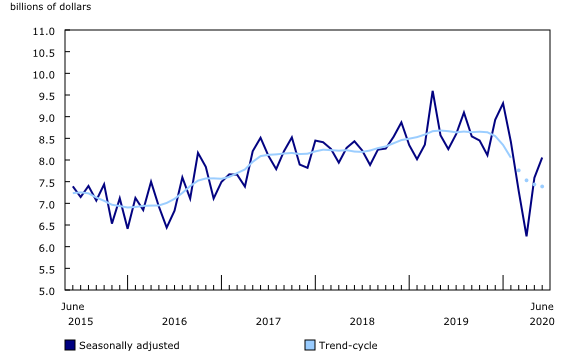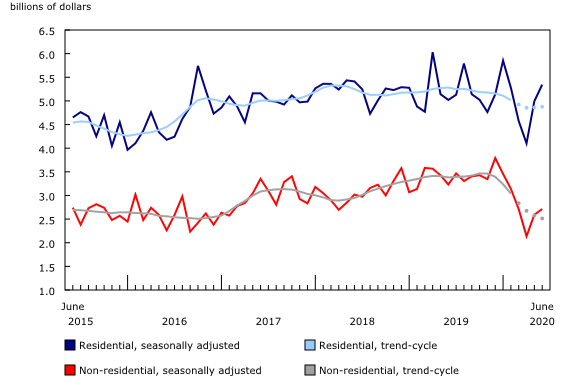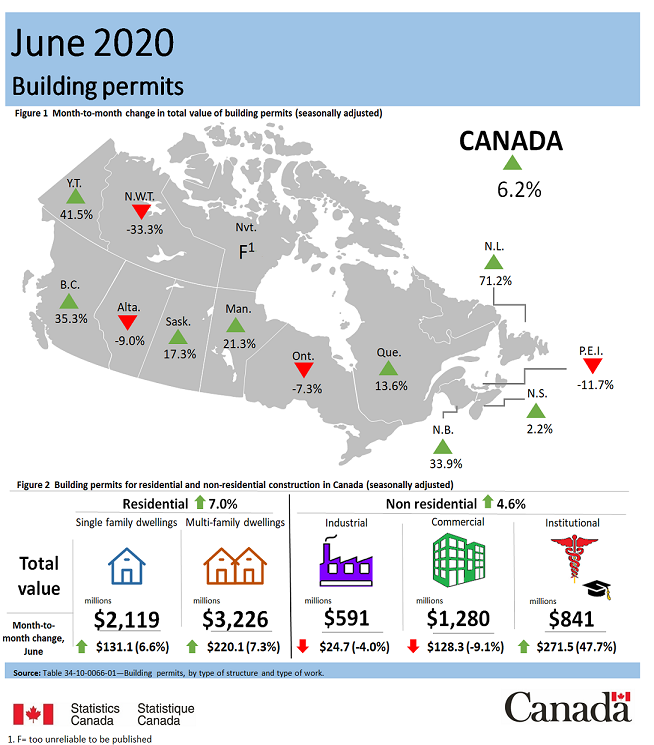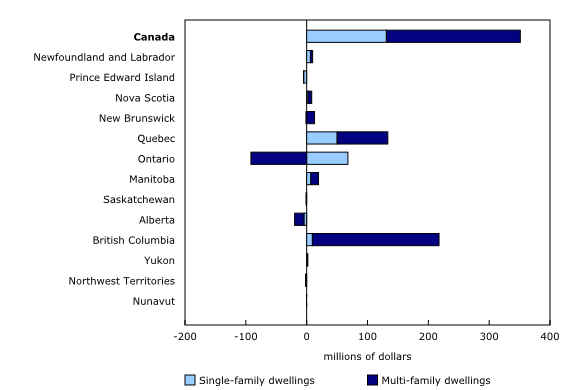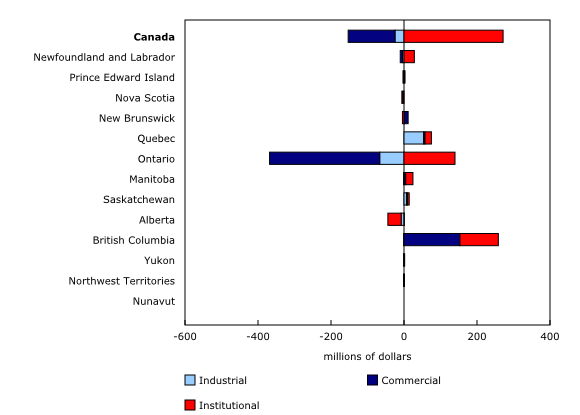Building permits, June 2020
Archived Content
Information identified as archived is provided for reference, research or recordkeeping purposes. It is not subject to the Government of Canada Web Standards and has not been altered or updated since it was archived. Please "contact us" to request a format other than those available.
Released: 2020-07-31
$8.1 billion
June 2020
6.2% 
(monthly change)
$66.9 million
June 2020
71.2% 
(monthly change)
$38.4 million
June 2020
-11.7% 
(monthly change)
$112.3 million
June 2020
2.2% 
(monthly change)
$74.0 million
June 2020
33.9% 
(monthly change)
$1,741.0 million
June 2020
13.6% 
(monthly change)
$3,213.9 million
June 2020
-7.3% 
(monthly change)
$244.7 million
June 2020
21.3% 
(monthly change)
$90.6 million
June 2020
17.3% 
(monthly change)
$641.1 million
June 2020
-9.0% 
(monthly change)
$1,819.5 million
June 2020
35.3% 
(monthly change)
$11.3 million
June 2020
41.5% 
(monthly change)
$3.7 million
June 2020
-33.3% 
(monthly change)
F
June 2020
F
(monthly change)
The $687 million dollar Oakridge Centre mixed use redevelopment project in the city of Vancouver helped raise the total national value of building permits 6.2% to $8.1 billion in June, to a level comparable to pre-COVID levels. Overall, seven provinces reported gains for the month.
Residential permits rise
The total value of residential permits was up 7.0% to $5.3 billion, with gains posted in six provinces. British Columbia posted its third largest value on record for residential permits in June, up 20.4% to $1.3 billion due to large projects such as the Oakridge Centre redevelopment.
The value of permits for single-family homes increased 6.6% to $2.1 billion, driven by gains in Quebec (+14.6%) and Ontario (+7.2%).
The value of permits issued for multi-family dwellings rose for the third consecutive month, up 7.3% to $3.2 billion, largely due to major projects in the census metropolitan area of Vancouver (+43.8%).
Institutional permits drive non-residential growth
The value of non-residential permits rose 4.6% to $2.7 billion in June.
Institutional permits were up 47.7% to $841 million, driven by gains in British Columbia (+162.8%) and Ontario (+60.3%).
In contrast, commercial (-9.1% to $1.3 billion) and industrial (-4.0% to $591 million) permits were down in June, following strong gains for both components in May.
Largest quarterly decline since the 2008 financial crisis
The second quarter of 2020 started with record declines in April, following the implementation of COVID-19-related measures by businesses and governments. The easing of those measures in May allowed construction intentions to bounce back and continue to advance in June. Despite the rebound seen in the last two months of the quarter, the value of building permits was down 12.8% compared with the first quarter, a fourth consecutive quarterly decline. The second quarter decrease was the largest reported since the fourth quarter of 2008, during the financial crisis.
Compared to the second quarter of 2019, the value of permits declined 17.4% nationally. Losses were reported across all provinces and territories except Newfoundland and Labrador, where quarterly gains in the institutional sector drove the increase in the total value of permits of 25.0%.
To explore the impact of COVID-19 on the socioeconomic landscape, please visit the Canadian Economic Dashboard and COVID-19.
For more information on housing, please visit the Housing statistics portal.
Note to readers
Unless otherwise stated, this release presents seasonally adjusted data, which facilitate month-to-month comparisons by removing the effects of seasonal variations. For information on seasonal adjustment, see Seasonally adjusted data – Frequently asked questions.
The Building Permits Survey covers over 2,400 municipalities, representing 95% of the Canadian population. The communities representing the other 5% of the population are very small, and their levels of building activity have little impact on the total for the entire population.
Building permit data are used as a leading indicator of activity in the construction industry.
The value of planned construction activities presented in this release excludes engineering projects (such as waterworks, sewers or culverts) and land.
For the purposes of this release, the census metropolitan area of Ottawa–Gatineau (Ontario and Quebec) is divided into two areas: the Ottawa part and the Gatineau part.
Unless otherwise specified, the highlights refer to seasonally adjusted current dollars and are ranked in terms of dollar change rather than percentage change.
Building components
Single-family dwellings: Residential buildings containing only one dwelling unit (for example, single-detached house, bungalow, linked home [linked at the foundation]).
Multi-family dwellings: Residential buildings containing multiple dwelling units (for example, apartment, apartment condominium, row house, semi-detached house).
Industrial buildings: Buildings used in the processing or production of goods, or related to transportation and communication.
Commercial buildings: Buildings used in the trade or distribution of goods and services.
Institutional and government buildings: Buildings used to house public and semi-public services, such as those related to health and welfare, education, or public administration, as well as buildings used for religious services.
Revision
Unadjusted data for the current reference month are subject to revision based on late responses. Data for the previous two months have been revised. Seasonally adjusted data for the previous three months have also been revised.
Trend-cycle estimates have been added to the charts as a complement to the seasonally adjusted series. Both seasonally adjusted data and trend-cycle estimates are subject to revision as additional observations become available. These revisions could be large and could even lead to a reversal of movement, especially at the end of the series. The higher variability associated with trend-cycle estimates is indicated with a dotted line on the chart.
For information on trend-cycle data, see the StatCan Blog and Trend-cycle estimates – Frequently asked questions.
Contact information
For more information, or to enquire about the concepts, methods or data quality of this release, contact us (toll-free 1-800-263-1136; 514-283-8300; STATCAN.infostats-infostats.STATCAN@canada.ca) or Media Relations (613-951-4636; STATCAN.mediahotline-ligneinfomedias.STATCAN@canada.ca).
- Date modified:


